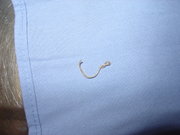 Toxocara canis
Toxocara canis|
From Wikipedia the free encyclopedia, by MultiMedia |
Toxocariasis is a parasitic infection with the Dog or cat roundworm, Toxocara canis or Toxocara cati, respectively. Ingestion of these worms causes the condition, visceral larval migrans.
Toxocariasis is a worldwide infection. Epidemiologic surveys show a 2-5% positive rate in healthy adults from urban Western countries and 14.2-37% in rural areas. In tropical countries, surveys show a positive rate of 63.2% in Bali, 86% in Saint Lucia, and 92.8% in Runion. Toxocariasis is most commonly a disease of children, typically children aged 2-7 years.
Adult worms of the Toxocara species live in the small intestine of Dogs and cats. They range from 4-12 cm in length. Almost all puppies are infected at or soon after birth. During the summer, Toxocara eggs are shed and become infective. They survive for years in the environment, and humans typically ingest the eggs by oral contact with contaminated hands. Once introduced into the human intestine, the eggs hatch, releasing the larvae. The larval form is less than 0.5 mm in length and 0.02 mm wide. The larvae penetrate the bowel wall and migrate through vessels to the muscles, liver, and lung and sometimes to the eye and brain as well.
Disease severity depends not only on the number of larvae ingested but also on the degree of allergic reaction. The inflammatory reaction causes epithelial cells to surround each larva, and, subsequently, a dense fibrous capsule invests each granuloma.
In suspected cases, diagnosis is confirmed by an increase in the anti-Toxocara excretory-secretory antigen IgE level
Mebendazole or thiobendazole are the treatments of choice.
Toxocariasis is almost always a benign, asymptomatic, and self-limiting disease, although brain involvement can cause brain damage, meningitis, encephalitis, or epilepsy. Ocular involvement may cause loss of visual acuity or unilateral blindness. Pulmonary and hepatic forms can cause protracted symptoms if the patient does not receive treatment.
The eggs of Toxocara species are widespread in parks, playgrounds, yards, and in homes and apartments where the occupants have Dogs or cats. Elimination of eggs from the environment is not possible; therefore, prevention depends on proper hygiene, including handwashing after contact with pets. Public policies that have attempted to eradicate Toxocara infection in Dogs and cats have had limited success.